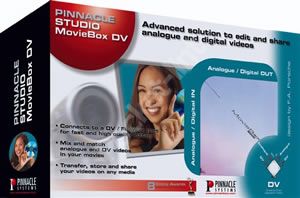In thousands of homes across the country sit mountains of videotapes, some with programmes you just haven't got around to watching yet, others with lovingly recorded cult TV series in meticulous order. The most essential kind hold family memories and it's this market at which the Moviebox USB is aimed. In other words, the kind of places where someone is king of the Camcorder but might not be PC Experts.
Our quick take
Unfortunately we cannot recommend the Moviebox. This is the sell-up kit to avoid, go higher up Pinnacle's range and get something that's more user- friendly for the minimal effort you have to invest in the installation of a PCI card. This way the range of compatible analogue equipment may also expand. Either that or buy an All-In-Wonder Radeon which nowadays features a healthy turn of speed for normal graphical duties as well as videocapture capability. It will also feature all the connecting cables needed to get the kit working quickly, rather than budgeting an extra £25-£40 if you don't have a USB 2.0 card.

Pinnacle MovieBox Studio USB - 1.5 / 5
| FOR | AGAINST |
|---|---|
|
|
Unlike many other entries in the Pinnacle range, there is no capture card to be installed. The only connection from the main unit to PC is the USB cable. The other component video or S-Video connections are looped into the capture device and TV to be used as an external monitor.
Which brings us neatly to the first of the Moviebox's problems- it's woefully under-equipped. Buy a branded ATi All-In-Wonder capture card and every necessary connection is supplied. Not so for the Moviebox. You get the USB cable and that's all. It's fair enough to expect the first set of component video cables to be supplied with your camcorder. When you need a second set, it's ridiculous not to supply it, considering they are bell wire in quality terms and cheap to supply. Not everyone is a hi-fi or PC enthusiast with these extra cables just lying around. So that's an immediate extra cost, to go with the £25 you'll have to fork out for the USB 2.0 card.
To its credit, the use of USB 2 resulted in no dropped frames whatsoever during capture. This flawless performance was helped by a cleanup and defragmentation of the hard disk before starting work. We took our project, a half-hour video of a retirement party, and processed it straight through without adding any titles. Another plus is the expansive tutorial, which explains the straightforward way the software works. It's a bonus since the Quick Start guide explains the connection method and then abandons you to the tutorial and the online forums. The only other literature is for the Pinnacle Studio 8 software manual and this is much better, at 250 pages.
It's much better but not perfect, simply because the literature assumes flawless installation. It has no advice, for example, when your five year old camcorder works flawlessly but your six year old VCR will not display video data for capturing at all- even when the phono plugs are rerouted via SCART converters. So it's assumed that your VCR is new enough to sport front mounted phono connectors or that you have an edit deck.
The software works almost flawlessly with just the catch that it defaults to MPEG after capturing and automatic chapter stops are set. From there you have to select video CD to burn to disk rather than rendering the same footage twice over. The software implies rendering must take place immediately. You can burn the Super/Video CD or DVD, or streaming video for the internet, straight after you finish the rendering process (the speed of which is specification dependent).
To recap
Good documentation is spoiled by uncharacteristically poor execution of the hardware. Stick to ATi’s All In Wonder range.
